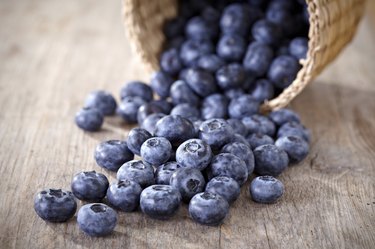
With their small size and dark blue coloring, blueberries are a treat that you can harvest in the wild, from your backyard or from your nearest grocery store or farmers market. Blueberries contain two simple sugars -- fructose and glucose -- as well as a number of other vitamins, minerals and nutrients. You can eat blueberries plain, add them to your favorite baked goods recipe or eat them as a topping for desserts or cereals.
Nutritional Content
Video of the Day
According to the United Stated Department of Agriculture, one cup of blueberries contains 84 calories per serving, 15 grams of sugar, as well as almost 4 grams of fiber and 1 gram of protein. Blueberries are also a good source of vitamin C, containing a little over 14 milligrams per serving. The same serving size of blueberries has a minimal amount of fats -- less than a gram per serving -- and no cholesterol. Indeed, like many fruits, blueberries are made up primarily of water, with almost 125 grams per serving.
Video of the Day
Simple Sugars
The 15 grams of sugar in blueberries is made up of two natural sugars -- fructose and glucose. Sugars are the simplest form of carbohydrates, so count these toward your carb intake. It is advised that your daily calorie count should be 45 to 65 percent carbohydrates. Given a 2000-calorie-per-day diet, that means no more than 900 to 1300 calories' worth of carbohydrates per day.
Forms of Blueberries
Blueberries are most commonly eaten fresh, frozen or canned. You can find fresh blueberries at grocery stores and farmer's markets in season. Out of season, you can occasionally find them in grocery stores, as well, but availability can vary greatly. Outside of their growing season, you can enjoy frozen blueberries as a good substitute for fresh berries. Canned blueberries are sometimes packaged in a heavy syrup used to preserve the berries, which contains added sugar.
Using Blueberries
You can add fresh blueberries to a wide range of foods, such as breakfast cereal for a pleasant morning treat, or to low-fat yogurt for a healthy snack. You can use frozen or fresh blueberries in baked goods — waffles, pancakes and muffins to name a few — or to smoothies. Canned blueberries are often used for jams or pie fillings, but because of their high added-sugar content, consider making your own pie filling or low-sugar jam at home. Increasingly common are dried blueberries, which you can sometimes find in specialty health food stores, plain or as part of a trail or granola mix.
- United States Department of Agriculture: Blueberries, Raw
- WomenFitness.net: Top 10 Health Benefits of Blueberries
- Harvard School of Public Health: Carbohydrates
- Blueberry Council: Blueberry Nutrition
- American Heart Association: Sugars and Carbohydrates
- Centers for Disease Control and Prevention: Carbohydrates
- MedBio: Carbohydrate Metabolism
- Harvard Medical School: Carbohydrates and Health